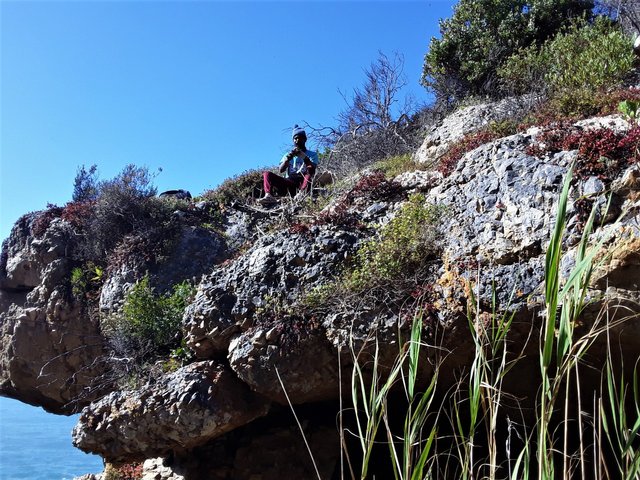For the traveling digital nomad there is always a further horizon to explore, a greener pasture to see or a better beach to admire. Such travel allows us to expand our perspective of the world and its contents, both geographical and social. And we digital nomads keep our eyes on the road and our hands upon the keyboard as we report and narrate our travel adventures to those who may be interested to follow suit on the road less travelled.

On today’s hiking trail along the south Cape coast of Africa, I came across something extremely rare. It was so rare that this encounter has been the only one so far in perhaps the past year for me. What was it that I encountered? It was a human. Yes, that’s how rare it is to come across locals here on this particular stretch of coastline called the Robberg Coastal Corridor, in Plettenberg Bay, which is on the southernmost shores of Africa.
On only a handful of occasions in a year, I might see some locals in the distance with their fishing gear, perhaps on a distant rock foraging for bait or casting their line out to sea in the hope of catching some fish. The rest of the days finds my trail deserted of any human life whatsoever. That’s how isolated and unknown this particular stretch of coastline is, despite the more popular shoreline just a few miles away.

On today’s encounter, it was not a fisherman that I met but rather an authentic local indigenous forager of local indigenous plant medicines. And this may well be a once-ff event, since such people are becoming rarer with each passing year, as old traditions die out and the youth turn to newer attractions.
While admiring one of my most attractive vistas on this part of the hiking trail, I was amazed to meet the local medicine man, if I may call him that, who was clambering on the very edge of the nearby cliff. He was reaching for some succulent plant and risking his life to stretch far enough to harvest it without falling the sheer drop to the shoreline down below, which would probably be fatal.

He managed to harvest one specimen of his chosen plant but had to leave the other as it was just too far out of reach for him. I called to him and struck up a conversation, asking him what he was collecting. He told me that the plant he is collecting is called “rooiwortel” (red root/carrot) in the local Afrikaans vernacular.
I did some research which confirmed what he said to me – it boosts libido and helps with stomach ailments. The Latin name is “Bulbine natalensis” being popular in the province of Kwazulu Natal, the traditional kingdom of the Zulus. The local Xhosa tribe here in the Cape also forage for these medicinal plants.

However, it was a local “Rasta” with dreadlocks that was doing the foraging today, since they are the most well-known herbalists and plant medicine foragers in this region. According to the actual science on the plant, it appears that this local medicinal succulent is good for improving testosterone levels, reducing estrogen (the female hormone) and thus acting as an aphrodisiac.
Besides that, it helps with diabetes, heart disease, arthritis and diarrhea. Even the gel or sap from the leaves is helpful for skin aliments. However, it was the root that my local forager was after. He showed me a sample and it looks innocuous enough. Nevertheless, the plant’s healing and medicinal properties are well-known in this country of South Africa as it has been harvested from the local indigenous bush for probably centuries already.

So it’s not just beautiful beaches and seascapes to be found here on the southernmost shoreline of Africa. Today I was most fortunate to meet a true local herbal medicine man and find out some secrets regarding the valuable local indigenous medicinal plants of southern Africa. And true to my digital nomad character, I am happy to share my discoveries on the road less traveled with you.

(photos my own)
Ref:
https://www.herbology.co.za/product/rooiwortel/

Blooming marvelous!🌺 This deserved a resteem.
Downvoting a post can decrease pending rewards and make it less visible. Common reasons:
Submit
Wow, great content, we've shared and upvoted on @southernafrica
Downvoting a post can decrease pending rewards and make it less visible. Common reasons:
Submit
Congratulations @julianhorack! You received the biggest smile and some love from TravelFeed! Keep up the amazing blog. 😍 Your post was also chosen as top pick of the day and is now featured on the TravelFeed.io front page.
Thanks for using TravelFeed!
@smeralda (TravelFeed team)
PS: Have you joined our Discord yet? This is where over 1000 members of the TravelFeed come together to chat. Join us!
Downvoting a post can decrease pending rewards and make it less visible. Common reasons:
Submit